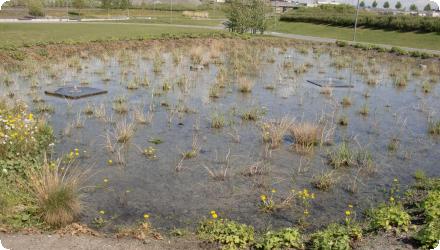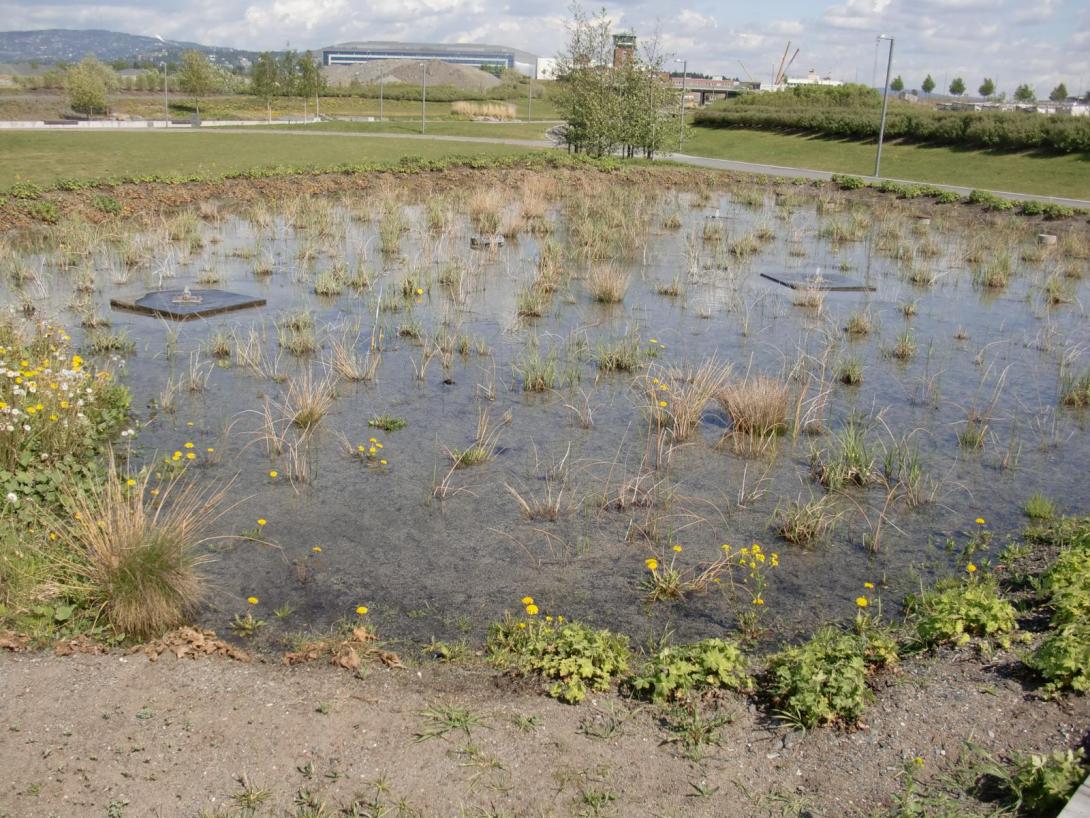Last update
2025
Summary
Fornebu is a brownfield development project with a focus on sustainable stormwater management and green infrastructure. The transformation of Fornebu, a decommissioned airport near Oslo, into a resilient, multifunctional urban landscape exemplifies nature-based stormwater management. Originally abandoned in 1998, the 340 ha brownfield site was redeveloped into a mixed residential and industrial area where stormwater systems were designed not as hidden infrastructure, but as visible, ecological assets. Swales, filter strips, permeable surfaces, detention basins and retention ponds were implemented to handle runoff and purify water, replacing conventional pipe networks. These measures were led and financed by Statsbygg (the Norwegian Directorate of Public Construction and Property), in collaboration with the City of Oslo, Bærum Municipality, and design input from Bjørbekk & Lindheim AS, supported by research from Interconsult ASA and Aalborg University.
From inception, the project aimed to enhance recreational and ecological values while ensuring cost-effective water management. Retention structures were sized to cope with flows from 1‑ to 20‑year return period storms, and water quality improvements were significant—modelled reductions of suspended solids (up to 90 %), phosphorus (≈ 65 %), copper (≈ 65 %), zinc (≈ 45 %) and nitrogen (≈ 40 %) were achieved.
Today, the Fornebu stormwater system is considered complete and serves as a meso‑scale model of blue‑green infrastructure integration, combining flood protection, water purification, biodiversity enhancement, recreational space and urban development stimulus. Its notable legacy is the shift from traditional stormwater management toward multifunctional, visible, sustainable urban design, resilient in the face of climate change and rooted in cross‑government collaboration.
From inception, the project aimed to enhance recreational and ecological values while ensuring cost-effective water management. Retention structures were sized to cope with flows from 1‑ to 20‑year return period storms, and water quality improvements were significant—modelled reductions of suspended solids (up to 90 %), phosphorus (≈ 65 %), copper (≈ 65 %), zinc (≈ 45 %) and nitrogen (≈ 40 %) were achieved.
Today, the Fornebu stormwater system is considered complete and serves as a meso‑scale model of blue‑green infrastructure integration, combining flood protection, water purification, biodiversity enhancement, recreational space and urban development stimulus. Its notable legacy is the shift from traditional stormwater management toward multifunctional, visible, sustainable urban design, resilient in the face of climate change and rooted in cross‑government collaboration.
Position
Latitude
59.9019
Longitude
10.6229
Project
NWRM
National Id
Norway_01
Installation date
2002-2015
Contact
Martyn Futter SLU
RBD code
NO5101
Transboundary
0
Photo gallery
Location of the project
Fornebu is a 340 ha brownfield redevelopment of the old Olso airport.
Project's objectives
Regulation of hydrological cycle and water flow
Flood control and flood risk mitigation
Self-regulation of water by filtration / storage / accumulation by ecosystems
Natural assimilation (purification) of effluents through dilution, dispersion, and physicchemical processes
Flood control and flood risk mitigation
Self-regulation of water by filtration / storage / accumulation by ecosystems
Natural assimilation (purification) of effluents through dilution, dispersion, and physicchemical processes
Involved Partners
| Authority type | Authority name | Role | Comments |
|---|---|---|---|
Climate zone
cool temperate moist
Temperature
6
Precipitation
778
Annual rainfall range
600 - 900 mm
Runoff coefficient range
0.5 - 0.7
Runoff range
300 - 450 mm
Evapotranspiration
200
Imperviousness
40
Imperviousness range
40 - 60%
Slope range
0-1%
Vegetation class
grass/turf
Water bodies: Ecological Status
Bad
Water bodies: Chemical Status
Failing to achieve good
Water quality status
Water quality was degraded prior to brownfield redevelopment. There is significant local pollution related to the old airport. Pollutants include oil, PAHs, heavy metals and de-icing chemicals.
Project scale
Large
Project scale specification
Fornebu is a 340 ha brownfield redevelopment
Performance timescale
Immediate
Project area
340
Area subject to Land use change or Management/Practice change (ha)
340
Size unit
ha
Environmental responsibility and a need to balance competing demands were the key guiding principles behind the redevelopment plan. The plan was to develop a functional, multi-use urban area with recreational, residential and industrial areas. The development had to be acceptable to the general Norwegian public as well as area residents and administrators.
The measures are deisgned to treat a range of events with return times ranging from 1 to 20 years. Design criteria are based on long-term average summer rainfall.
Design capacity description
The systems were designed based flows expected with a 1 year return period for channels and a 20 year return period for detention ponds. The average runoff was based on estimates of daily summer rainfall between 1957 and 1995. The wet ponds had design criteria of 230 m3 per effective hectare.
The availability of the entire brownfield site for redevelopment greatly simplified the development of a master plan incorporating sustainable urban drainage features. While there were challenges with communication between different levels of government, these were resolved. The Statsbygg commitment to sustainable urban environments and substantial financial investment allowed this project to be implemented.
Winter conditions, snow and ice are a challenge to the implmentation of sustainable urban drainage systems at Fornebu and other northern cities.
Having a brownfield site and a governance environment favorable to sustainable multi use urban landscape were key factors in the success of Fornebu.
Positive influence effectiveness
Access to funds for implementation did not seem to be a problem at this site.
Negative influence effectiveness
Multiple levels of government made it challenging to start project implementation.
Total cost
€500,000 - €2,000,000
Costs total information
Total cost is not known
Costs investment information
Total investment cost is not known
Costs land acquisition information
No land acquisition costs as land was already owned by Norwegian government
Financing authorities
Type of funding
National funds
Type of funding
Local funds
Compensations
0
Policy context
The old Oslo airport at Fornebu was a brownfield site in need of redevelopment. The urban planning challenge was to redevelop the site in a sustainable manner supporting both residential and industrial uses while encouraging environmental responsibility
Land ownership
Statsbygg (Norwegian Directorate of Public Construction and Property)
Community involvment
No
Design consultation activity
| Activity stage | Name | Key issues | Comments |
|---|
Policy target
| Target purpose |
|---|
|
Runoff control
|
|
Peak-flow reduction
|
|
Pollutants Removal
|
|
Oher Societal Benefits
|
|
Increase Water Storage
|
|
Groundwater Recharge
|
|
Improved Biodiversity
|
Policy pressure
| Pressure directive | Relevant pressure |
|---|
Policy impact
| Impact directive | Relevant impact |
|---|---|
|
Other non-EU
|
Storm Overflows
|
|
Other non-EU
|
Community (sustainable built environment)
|
Requirement directive
| Requirement directive | Specification |
|---|
Policy challenges requirements
Norwegian government commitment to environmental sustainability : The Fornebu development was motivated primarily by national as opposed to European priorities.
Contractual arrangements
0
| Arrangement type | Responsibility | Role | Name | Comments |
|---|
Part of wider plan
0
Wider plan type
| Wider plan type | Wider plan focus | Name | Comments |
|---|
Maintenance
A similar level of maintenance as is needed for similar green infrastructure in other cities will be needed.
The Fornebu brownfield redevelopment has clear direct benefits as it provides space for living, employment and recreation in a crowded urban area. The specific benefits of the measures in Fornebu are harder to quantify as they cannot really be considered in themselves but must be seen as part of the complete redevelopment picture.
Water-related ecosystem services include flood protection and security, wastewater services and improved coastal status due to a reduction in polluted runoff.
Water-related ecosystem services include flood protection and security, wastewater services and improved coastal status due to a reduction in polluted runoff.
Key ancillary benefits include more living space and a sustainable multi use urban environment supporting recreation, residential and industrial land use.
Information on retained water
The total retained volume of water is hard to assess as the Fornebu plan consists of multiple measures.
Increased water storage
230
Increased water storage unit
m3/ha
Information on runoff reduction
Large qualitiative reductions in runoff peaks. The entire Fornebu master plan had a goal of runoff attenuation and control. The channels are designed to deal with flows of 1.25 m3 s-1 while the detention ponds are designed to handle a flow of 2.75 m3s-1
Information on Peak flow rate reduction
Large qualitative reductions in peak flow could be expected when compared to the old Fornebu airport
Information on Soil moisture
Extensive use of swales and soakaways will lead to improvements in soil moisture status and soil storage capacity compared to traditional impervious urban features. It is hard to make a “before / after” comparison in this case as the data do not exist and the change in land use is too large.
Ecosystem erosion control
0
Water quality overall improvements
Positive impact-WQ improvement
Information on Water quality overall improvements
based on mdeolling results and design criteria
Water quality Improvements Phosphorus (P)
60
Water quality Improvements (P) unit
% reduction pf pollutant
Water quality Improvements Nitrogen (N)
40
Wq Improvements n unit
% reduction pf pollutant
Water quality Improvements Total Suspended Solid (TSS)
80
Water quality Improvements (TSS) unit
% reduction pf pollutant
Water quality Improvements Copper (Cu)
65
Water quality Improvements (Cu) unit
% reduction pf pollutant
Water quality Improvements Zinc (Zn)
45
Water quality Improvements (Zn) unit
% reduction pf pollutant
Soil quality overall soil improvements
Positive impact-SQ improvement
Information on Soil quality overall soil improvements
Overall soil quality in Fornebu has been improved, primarily due to the removal of approximately 200,000 m3 of contaminated soil .This improvement is not related to green infrastructure, but to brownfield remediation.
Information on Soil quality overall soil pollution
brownfield improvement included removal of contaminated soil, PAH, oil and deicing fluids were all problems
1
more aquatic habitat and greenspace
Key lessons
Success was dependent on communication between different levels of government and a clear vision for a sustainable, multi-use urban environment
Success factor(s)
| Success factor type | Success factor role | Comments | Order |
|---|---|---|---|
|
Financing possibilities
|
1
|
||
|
Attitude of decision makers
|
main factor
|
Commitment of Statsbygg, to a sustainable, multi-use redevelopment of the Fornebu brownfield so as to support recreational, residential and industrial land use. |
2
|
|
Attitude of relevant stakeholders
|
3
|
Driver
| Driver type | Driver role | Comments | Order |
|---|---|---|---|
|
Organisation committed to it
|
main driver
|
1
|
Flexibility adaptability
It is unclear how flexible or adaptable Fornebu is to changing baseline conditions. Climate change may have both negative and positive effects. Warmer temperatures would reduce the problems associated with snow and ice. Changing precipitation patterns could alter the effectiveness of the Green Infrastructure for stormwater management.
Transferability
Fornebu provides a model for brownfield redevelopment and shows that sustainable urban drainage systems can be integrated into a multi-functional urban landscape.
Source(s)
English

